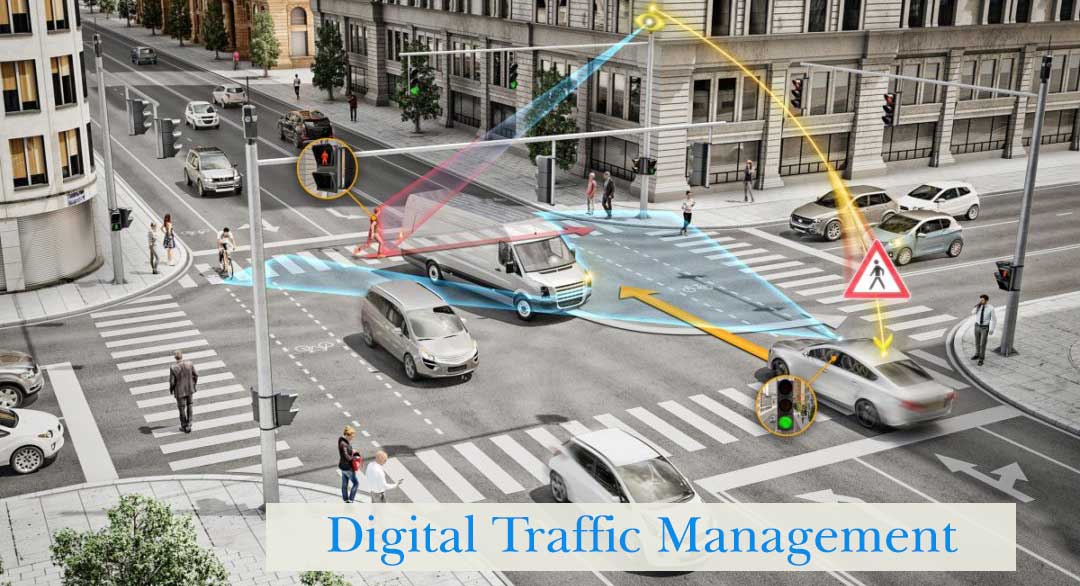Digital Traffic Management
As cities grow and traffic congestion increases, effective traffic management becomes crucial. Traditional methods of traffic management, such as traffic signals and signage, are becoming inadequate in handling the complexities of modern traffic patterns. However, with the advent of digital technologies, the field of traffic management is rapidly evolving, and the concept of digital traffic management is emerging as a promising solution.
Digital traffic management refers to the use of digital technologies, such as artificial intelligence, data analytics, and connected vehicles, to optimize traffic flow, improve safety, and reduce congestion.
This article will explore the benefits of digital traffic management and the technologies that make it possible.
Benefits of Digital Traffic Management
One of the main benefits of digital traffic management is its ability to reduce congestion on the road. By using real-time data on traffic flow, digital traffic management systems can adjust traffic signals, reroute traffic, and manage traffic flow to optimize traffic patterns and reduce congestion. This, in turn, reduces travel time and fuel consumption and can improve air quality.
Digital traffic management systems can also improve safety on the road. By monitoring traffic patterns and detecting potential hazards, such as accidents, road closures, or inclement weather, these systems can alert drivers and other road users to potential dangers, reducing the likelihood of accidents. They can also assist emergency services in responding to accidents and other incidents more quickly and efficiently.
In addition to reducing congestion and improving safety, digital traffic management can provide economic benefits. Reducing travel time and fuel consumption can reduce the cost of transportation for businesses and individuals. It can also increase productivity by reducing travel time for workers and goods and improve citizens’ overall quality of life by reducing stress and improving air quality.
Technologies Used in Digital Traffic Management
Digital traffic management relies on a combination of technologies to achieve its goals. Some of the key technologies used in digital traffic management are:
- Artificial Intelligence (AI): AI can be used to analyze large amounts of data on traffic patterns, road conditions, and weather and make predictions about future traffic flows. By using these predictions, traffic management systems can adjust traffic signals, reroute traffic, and manage traffic flow to reduce congestion and improve safety.
- Data Analytics: Data analytics can be used to collect and analyze real-time data on traffic flow, accidents, and road conditions. By analyzing this data, traffic management systems can identify areas where improvements are needed and take action to prevent accidents and reduce congestion.
- Connected Vehicles: Connected vehicles are equipped with sensors and communication devices that allow them to communicate with each other and with the transportation infrastructure. This technology enables real-time monitoring of traffic flow and road conditions and communication between vehicles to improve safety.
- Smart Traffic Signals: Smart traffic signals are traffic signals that are equipped with sensors and communication devices that allow them to communicate with each other and with the transportation infrastructure. This technology enables real-time adjustment of traffic signals to optimize traffic flow and reduce congestion.
- Predictive Analytics: Predictive analytics uses historical data and machine learning algorithms to make predictions about future traffic patterns. By using these predictions, traffic management systems can adjust traffic signals, reroute traffic, and manage traffic flow to reduce congestion and improve safety.
Challenges and Considerations
While digital traffic management has the potential to bring significant benefits, there are also some challenges and considerations to be aware of. One of the main challenges is the need for a reliable and secure communication network. Digital traffic management systems rely on real-time data and communication between various technologies, and any disruption in the network can cause significant issues.
Another consideration is the need to protect data privacy and security. Digital traffic management systems collect and analyze large amounts of data, and it is essential to ensure that this data is protected and used ethically. Regulations and policies must be implemented to safeguard data privacy and security.
Furthermore, the implementation of digital traffic management systems requires significant investment in both infrastructure and technology. Governments and other organizations must be willing to invest in these systems to achieve the potential benefits.
Another consideration is the need for public awareness and engagement. Digital traffic management systems require cooperation and participation from all road users, including drivers, cyclists, and pedestrians. The public must be educated about the benefits of these systems and encouraged to use them to achieve their full potential of these systems.
Digital Traffic Management and Traffic Safety
Digital traffic management and traffic safety go hand in hand. Digital traffic management systems can help improve traffic safety by reducing congestion, improving traffic flow, and reducing the risk of accidents. Here are some ways in which digital traffic management can improve traffic safety:
- Reducing congestion: Congestion on the roads is a major contributing factor to traffic accidents. Digital traffic management systems can help reduce congestion by optimizing traffic flow and reducing bottlenecks. This can help reduce the risk of accidents caused by sudden stops or lane changes.
- Intelligent traffic signals: Digital traffic management systems can use artificial intelligence to optimize traffic signal timings based on real-time traffic data. This can help reduce congestion and improve traffic flow, reducing the risk of accidents caused by sudden stops or red light violations.
- Real-time traffic data: Digital traffic management systems can provide real-time traffic data to drivers, allowing them to make informed decisions about their route and driving behavior. This can help reduce the risk of accidents caused by sudden lane changes or merging.
- Pedestrian safety: Digital traffic management systems can improve pedestrian safety by providing real-time traffic patterns and behavior data. This can help drivers be more aware of pedestrians and reduce the risk of accidents.
- Emergency response: Digital traffic management systems can improve emergency response times by providing real-time data about traffic conditions and road closures. This can help emergency services respond more quickly to accidents and reduce the risk of further accidents caused by delayed response times.
While digital traffic management systems can help improve traffic safety, it is important to note that they are not a substitute for safe driving behavior. Drivers must still be responsible for their own road behavior and follow traffic laws and regulations.
In addition, digital traffic management systems must be designed with safety in mind. For example, intelligent traffic signals must be designed to provide sufficient warning to drivers before changing, and pedestrian crossings must be clearly marked and well-lit to improve visibility.
Digital traffic management systems have the potential to significantly improve traffic safety by reducing congestion, optimizing traffic flow, and providing real-time data to drivers and emergency services. However, these systems must be designed with safety in mind and should not be seen as a substitute for safe driving behavior.
Governments and other organizations must continue investing in digital traffic management systems to improve traffic safety and reduce road congestion. By working together to create safe and efficient traffic management systems, we can improve the quality of life for people living in urban areas and make our roads safer for everyone.
Digital Traffic Management and Digital City
Here are some ways in which digital traffic management can contribute to creating a digital city:
- Intelligent transportation systems (ITS): Digital traffic management systems are a key component of intelligent transportation systems, which use advanced technologies to optimize the movement of people and goods. By implementing ITS, cities can reduce congestion and improve mobility, reducing pollution and carbon emissions.
- Integrated data management: Digital traffic management systems generate large amounts of data, which can be used to improve the efficiency of other city systems. For example, data generated by traffic management systems can be used to optimize public transportation routes, improve emergency response times, and provide real-time information to city residents.
- Smart city infrastructure: Digital traffic management systems require a robust and interconnected infrastructure, including high-speed internet, sensors, and communication networks. By investing in this infrastructure, cities can lay the foundation for a wide range of smart city applications, including smart energy grids, waste management systems, and public safety systems.
- Public engagement: Digital traffic management systems require cooperation and participation from all road users, including drivers, cyclists, and pedestrians. Cities can encourage more sustainable and safe transportation behaviors by engaging the public and providing them with real-time data and information.
- Future-proofing: As technology continues to evolve, digital traffic management systems must be designed to be adaptable and scalable. Cities must plan for the long-term and consider how these systems will fit into the future of transportation, including autonomous vehicles, connected infrastructure, and alternative modes of transportation.
Digital traffic management is important in creating a smart and connected digital city. By using advanced technologies, including artificial intelligence, data analytics, and connected vehicles, digital traffic management systems can optimize traffic flow, improve safety, and reduce congestion on the roads.
However, implementing these systems requires significant investment in infrastructure and technology, as well as public awareness and engagement. Governments and other organizations must be willing to invest in these systems and work to educate the public about their benefits.
By creating a smart and connected digital city, we can improve the quality of life for people living in urban areas and create a more sustainable future.
Digital Traffic Management and Advanced driver-assistance system (ADAS)
Advanced driver-assistance systems (ADAS) are another crucial element of digital traffic management. ADAS uses sensors, cameras, and algorithms to help drivers avoid accidents and improve road safety. These systems can provide real-time information to drivers, such as speed limits, traffic conditions, and potential hazards, allowing them to make more informed driving decisions.
Here are some ways in which digital traffic management and ADAS can work together to improve traffic safety:
- Traffic signal optimization: Digital traffic management systems can use data from ADAS to optimize traffic signal timings and reduce congestion. For example, sensors can detect the number of cars waiting at a red light and adjust the signal timing to minimize waiting times.
- Collision avoidance: ADAS can detect potential collisions and alert drivers to take action, such as applying brakes or steering to avoid the collision. By working with digital traffic management systems, ADAS can also provide real-time information to drivers about potential hazards, such as road closures or accidents, helping them avoid dangerous situations.
- Intelligent speed adaptation: Digital traffic management systems can use data from ADAS to monitor traffic speeds and adjust speed limits to improve traffic flow and reduce accidents. For example, if traffic is moving slowly due to congestion, the system can automatically reduce the speed limit to help prevent accidents.
- Smart parking: Digital traffic management systems can work with ADAS to improve city parking. For example, sensors can detect available parking spaces and send the information to drivers’ navigation systems. This can reduce congestion and improve safety by reducing the amount of time drivers spend searching for parking.
- Road infrastructure monitoring: Digital traffic management systems can use data from ADAS to monitor the condition of roads and infrastructure, such as potholes, cracks, and other hazards. This information can be used to prioritize maintenance and repair work, improving safety and reducing accidents.
Overall, digital traffic management and ADAS integration can significantly impact urban traffic safety in urban areas. By working together, these systems can optimize traffic flow, reduce congestion, and improve safety for all road users. As technology evolves, these systems will likely become even more sophisticated and effective, helping to create safer and more sustainable cities for everyone.
Notice:
- HTN, together with leading ADAS systems providers, aims at traffic systems facilitating the future mass mobility
- HTN addresses traffic flow dynamics and has developed novel traffic management systems yielding high lane capacities and low travel time on freeways and urban roads.
- HTN initiated its collaboration with the industry-leading standard provider, the Society of Automotive Engineers (SAE)



